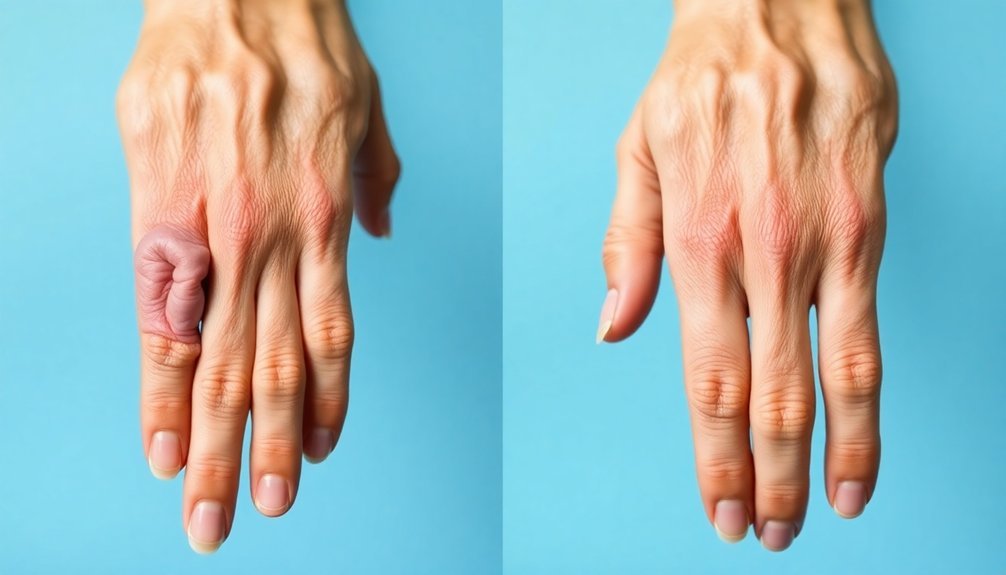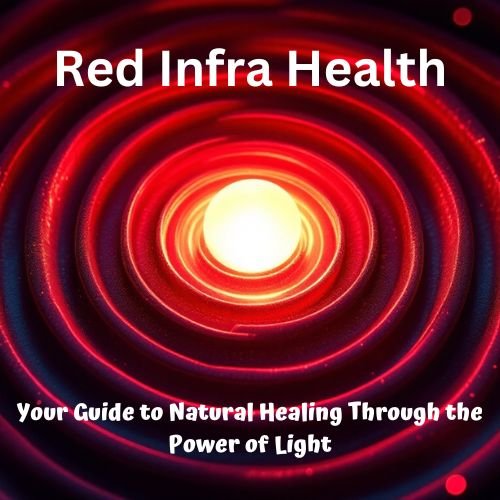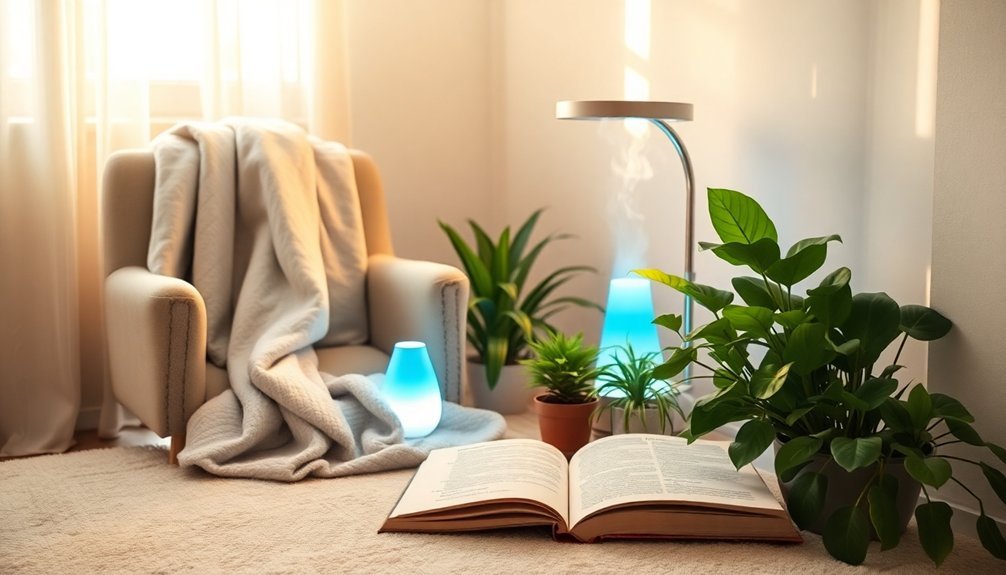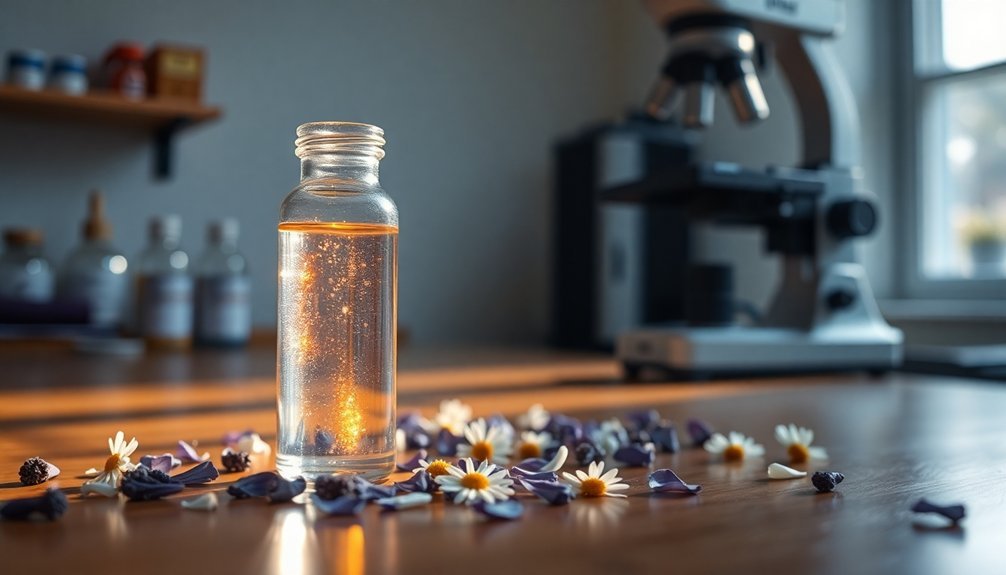Combining multiple therapies can dramatically transform your arthritis pain within 12 weeks. You'll often see significant improvement when pairing traditional treatments like NSAIDs and physical therapy with emerging options like red light therapy. Clinical studies show up to 70% reduction in pain and inflammation using this thorough approach. Regular low-impact exercise, stretching, and targeted physical therapy sessions strengthen muscles while improving joint function. Cold therapy reduces swelling, while heat therapy relaxes stiff muscles. Adding alternative treatments like acupuncture or CBT can enhance your results. Discovering the right combination of therapies will open your path to lasting relief.
Understanding Arthritis Pain Management

When it comes to managing arthritis pain, you've got multiple effective strategies at your disposal. Medical interventions, including corticosteroid shots and gel injections, can provide significant relief by reducing inflammation and improving joint lubrication. Joint injections are limited to four shots annually with a six-week minimum between treatments.
If you're experiencing severe pain, your doctor might recommend tramadol or other targeted joint injections.
Physical therapy and exercise form the cornerstone of long-term pain management. You'll benefit from low-impact activities like swimming and cycling, while stretching and range-of-motion exercises help maintain joint flexibility.
Don't overlook the value of working with an occupational therapist who'll teach you how to protect your joints during daily activities.
You can complement traditional treatments with alternative therapies. Acupuncture might help reduce pain, while heat and cold therapy can soothe stiff joints and decrease swelling.
If you're dealing with chronic pain, consider radiofrequency ablation or cognitive behavioral therapy to address both physical and mental aspects of pain management.
Self-management tools are essential for ongoing relief. You'll want to incorporate mindfulness meditation, maintain proper nutrition, and use assistive devices when needed.
Red Light Therapy Basics
Thanks to decades of scientific advancement, red light therapy has emerged as a promising treatment for arthritis pain. Originally developed by NASA, this non-invasive treatment uses specific wavelengths of red and near-infrared light to penetrate deep into your skin, triggering your body's natural healing processes.
When you undergo red light therapy, the light waves stimulate your cells' mitochondria, enhancing cellular function and repair. This process helps reduce inflammation in your arthritic joints while promoting tissue healing and improved mobility. The therapy works by increasing ATP production in your cells, providing them with more energy to fight inflammation and repair damage.
You'll find that the therapy doesn't use harmful UV rays, making it a safe option with minimal side effects.
You can access red light therapy through various devices, including panels for larger areas and handheld wands for targeted treatment. Whether you're using it at home or in a clinical setting, consistency is key to achieving the best results.
The MOVE+ and similar portable devices make it convenient to maintain a regular treatment schedule. You'll want to monitor your symptoms and adjust your treatment accordingly, as the therapy works by stimulating your body's natural healing mechanisms, helping to manage pain and reduce inflammation in arthritic joints.
Patient Journey Stories

Countless patients have transformed their lives through innovative arthritis treatments, finding renewed hope and mobility. You'll discover that both traditional and alternative therapies have helped people regain their active lifestyles, with many reporting significant improvements through treatments like genicular nerve radiofrequency ablation and red light therapy.
- A growing number of patients report immediate pain relief after their first red light therapy session, with sustained improvements when they maintain consistent daily treatments.
- Young arthritis patients are breaking through age-related stereotypes, successfully managing their condition with non-invasive treatments that let them maintain active lifestyles.
- Hand arthritis sufferers have found remarkable success combining red light therapy with other treatments, allowing them to return to activities they love.
- Multiple patients share stories of overcoming chronic back pain and knee aches through personalized treatment plans that include red light therapy.
While you might face initial challenges with diagnosis and treatment selection, there's hope in knowing that others have successfully navigated similar journeys. Traditional solutions like total knee replacement may not always provide complete relief, as some patients discover alternative treatments are necessary for their pain management.
Dr. Anne Abrahamson confirms that patients consistently report improved joint function and mobility when following proper treatment protocols, especially with non-invasive options like red light therapy.
Clinical Research Findings
Recent clinical trials show you'll find meaningful improvements in arthritis pain management through multiple treatment approaches, from gene therapy to cooled radiofrequency ablation.
You can expect varying results over time, with studies indicating that some treatments, like IV ketamine therapy, offer quick relief while others, such as the BEAR technology for knee repair, demonstrate sustained benefits. Clinical research shows that platelet-rich plasma with HA provides superior pain reduction compared to hyaluronic acid treatments alone.
The latest research reveals promising outcomes when comparing traditional methods to newer innovations, including internet-based pain management programs and targeted biological therapies that help reduce inflammation.
Treatment Outcomes Over Time
Clinical research reveals compelling evidence about arthritis treatment effectiveness over time. You'll find that different treatments yield varying results, with some showing more promise than others for long-term pain management.
Baricitinib, either alone or combined with methotrexate, stands out by providing 9-10 weeks of pain-free life and 5-7 weeks of improved physical health compared to methotrexate alone over a year's time. Pain improvement occurs much faster with baricitinib treatments, taking only 8-12 weeks to achieve 70% pain reduction.
Key findings from long-term studies show:
- 77.9% of patients using baricitinib alone and 80.8% using it with methotrexate achieved significant pain improvement within 24 weeks.
- Opioids don't provide better pain control than non-opioid medications over 12 months for chronic back pain or osteoarthritis.
- Patients with moderate to severe osteoarthritis typically need increasing medication and healthcare resources over time.
- Adherence to prescribed medications directly impacts pain control and disease progression.
You'll get better results by combining medication with lifestyle changes, including regular exercise and stress reduction. A treat-to-target approach, focusing on your individual functional goals, can effectively manage chronic musculoskeletal pain.
Structured symptom monitoring and working closely with your healthcare provider will enhance your treatment's effectiveness.
Comparing Multiple Therapy Methods
Drawing from extensive research data, multiple therapy approaches offer distinct advantages for managing arthritis symptoms.
You'll find that biological and targeted synthetic DMARDs, particularly TNF inhibitors, show similar effectiveness levels when compared to non-TNFi treatments. While there's no clear winner among these medications, you can work with your doctor to find the best match for your specific condition. Studies show that strict bed rest can lead to significant muscle strength loss of up to 1.5% per day over two weeks.
You've got several rehabilitation options at your disposal. Traditional methods like heat therapy, cold therapy, and electrical stimulation can provide relief, while hydrotherapy and fluidotherapy offer additional benefits for joint pain and muscle spasms.
If you're dealing with walking difficulties, orthotic devices and shoe modifications can substantially reduce your pain during weight-bearing activities.
When it comes to alternative treatments, you might consider acupuncture, which shows promise in improving function and quality of life, though its benefits may partly stem from the placebo effect.
You'll also want to keep an eye on emerging therapies like PRP injections, BMAC, and new ultrasound imaging technologies. These experimental treatments are currently under investigation and might offer additional options for managing your arthritis symptoms in the future.
Latest Research Trial Results
Through groundbreaking clinical trials, researchers have uncovered promising new treatments for arthritis sufferers. You'll be encouraged to know that methotrexate has shown remarkable effectiveness in treating knee osteoarthritis, with participants experiencing significant pain and stiffness reduction after six months of treatment.
This breakthrough offers hope if you're among the millions who haven't responded well to conventional treatments. The study spanned across fifteen UK hospitals to ensure comprehensive results.
Clinical Trial Success
A recent study of 155 patients demonstrated methotrexate's effectiveness against knee osteoarthritis pain, outperforming placebo treatments.
Regenerative Breakthroughs
PRP therapy now offers longer-lasting relief compared to traditional corticosteroid injections for osteoarthritis symptoms.
Innovative Treatments
New research shows promising results with izokibep for psoriatic arthritis, improving both joint pain and skin conditions.
Stem Cell Solutions
Studies using autologous mesenchymal stem cells and adipose-derived stromal cells reveal potential new paths for knee osteoarthritis treatment.
The latest research also highlights advancements in gene therapy and tissue engineering, targeting inflammatory proteins and cartilage regeneration. If you're struggling with arthritis, these emerging treatments could offer new options beyond traditional pain management approaches.
Treatment Comparison Results

Recent studies comparing upadacitinib and adalimumab have revealed compelling results over a three-year period. If you're considering treatment options, you'll want to know that upadacitinib has shown consistently better clinical responses across all endpoints compared to adalimumab, particularly when combined with methotrexate.
Both medications have similar overall safety profiles, with comparable rates of serious adverse events and infections. However, upadacitinib does show higher rates of specific conditions like herpes zoster, lymphopenia, and hepatic disorders. 46% of upadacitinib patients completed the full three years of continuous treatment.
The good news is that both treatments have similar rates of major cardiac events and malignancies.
The bigger picture shows that today's RA treatments are more effective than ever. You'll see better outcomes when starting treatment early, especially with a treat-to-target approach.
Whether you're using biological DMARDs or targeted synthetic DMARDs, you can expect improved disease control and better functional outcomes.
Most patients who follow strict treatment regimens experience limited radiographic damage and maintain good functional ability, even after 10 years. This is particularly true when treatment begins early and follows targeted therapeutic strategies.
Measuring Pain Relief Progress
Along with finding the right treatment, measuring your pain relief progress accurately is crucial for managing arthritis effectively. You'll need to work with your healthcare provider to track changes in your pain levels and overall functioning using validated assessment tools that give reliable, consistent results.
- Use the Numerical Rating Scale (NRS) to rate your daily pain intensity from 0-10, helping you and your doctor monitor short-term changes.
- Track your pain's impact on daily activities with the Brief Pain Inventory (BPI), which measures interference in seven key areas of functioning.
- Consider using the Visual Analog Scale (VAS) for more precise measurements, especially if you're participating in clinical research.
- Document your pain patterns using multidimensional tools like the Short-form McGill Pain Questionnaire to capture both physical and emotional aspects.
Don't let language barriers or cultural differences prevent accurate pain reporting – work with your healthcare team to find assessment methods that work best for you.
Remember that chronic pain is complex, so you'll likely need multiple measurement tools to get a complete picture of your progress.
Regular self-assessment helps your doctor adjust your treatment plan for the best results.
Photobiomodulation Success Rates

You'll find impressive success rates with photobiomodulation therapy, as clinical studies show pain reduction of up to 90% in rheumatoid arthritis patients.
Regular treatment sessions can lead to sustained relief and improved joint function, with success rates ranging from 70-90% for various arthritic conditions.
Your progress can be tracked through measured pain scores before and after treatment, helping to document the therapy's effectiveness for your specific case.
Measured Pain Score Improvements
Through extensive clinical trials and research, photobiomodulation has demonstrated remarkable success rates in reducing arthritis pain, with studies showing 70-90% effectiveness for both osteoarthritis and rheumatoid arthritis patients.
You'll find significant improvements in pain scores, particularly in rheumatoid arthritis cases where patients experience up to 90% pain attenuation. Clinical data shows a mean improvement of -0.7 in pain at rest compared to placebo for osteoarthritis patients.
When you're considering photobiomodulation therapy, here are the key pain improvement metrics you should know:
- You can expect statistically significant improvements in both pain and disability scores for knee osteoarthritis
- Your arthritis-related inflammation levels will decrease, supported by measured reductions in oxidative damage
- You'll likely experience enhanced joint function and mobility, with improved range of motion scores
- Your cellular activity will increase, leading to better blood flow and tissue repair in arthritic areas
While individual results may vary, the documented pain score improvements consistently show that photobiomodulation offers substantial relief for both osteoarthritis and rheumatoid arthritis conditions, often outperforming traditional NSAID treatments in long-term pain management.
Light Therapy Treatment Outcomes
Research-backed clinical studies reveal impressive success rates for photobiomodulation therapy in treating arthritis conditions. You'll find that 70-90% of patients experience significant pain reduction and decreased inflammation after consistent treatment.
When you're dealing with rheumatoid arthritis, you can expect notable improvements in joint function and less morning stiffness.
While results for osteoarthritis are more varied, you'll still benefit from substantial pain relief and better mobility. The therapy's success stems from its ability to enhance blood circulation and trigger cellular repair mechanisms.
You're likely to see the best results when you combine PBM therapy with exercise, as this duo increases anti-inflammatory factors in your body.
You'll need regular sessions to maintain these positive outcomes, as the therapy works by stimulating your cells' mitochondrial activity and promoting tissue healing. The treatment's effectiveness depends on specific factors that your healthcare provider will adjust, including wavelength, duration, and application site.
When properly tailored to your condition, you can expect improved cartilage structure and reduced inflammatory responses, leading to better joint health and long-term pain management.
Joint Mobility Improvements
Regular movement remains essential for managing arthritis, with joint mobility improvements offering substantial relief from daily pain and stiffness. You'll notice enhanced flexibility and reduced inflammation as you combine targeted exercises with manual therapy techniques.
When you incorporate strengthening exercises, you're building vital support around your joints while improving their stability and function.
- Your joints will experience less swelling and pain through consistent physical activity, leading to better cartilage health through natural compression and decompression movements
- You'll maintain stronger muscles and bones around affected joints, considerably improving your balance and reducing fall risks
- Your energy levels will increase while fatigue decreases, helping you stay active and maintain a healthy exercise routine
- You'll gain greater independence in daily activities as your joint mobility improves
Red light therapy can amplify these benefits by promoting natural healing and reducing inflammation in your joints. This treatment works particularly well when combined with physical therapy, allowing you to exercise more comfortably and effectively.
Daily Living Activity Changes

Simple changes to your daily routines can dramatically reduce arthritis-related pain and strain. You'll find that using built-up handles on utensils and implementing assistive devices like canes or walkers can make a significant difference in how you move through your day.
When you're at work, position your computer at the right height and use supportive chairs with proper wrist supports to minimize joint stress.
You'll notice improvements in challenging activities like bathing, dressing, and kitchen tasks when you incorporate helpful tools and new approaches. Take regular breaks during activities, and don't push yourself too hard – pacing is key.
If you're struggling with tasks like kneeling or bending, try modifying your approach or using assistive devices designed for these movements.
Stay active with low-impact exercises like swimming, yoga, or cycling, which can help build strength while managing pain. Remember that weather conditions might affect your joints, so you'll need to adjust your activities accordingly.
Keep in touch with your healthcare provider to monitor your progress and make necessary adjustments to your daily routine as your needs change.
Long Term Treatment Benefits
While daily adjustments help manage arthritis symptoms, long-term treatment provides lasting relief and improved quality of life. Research shows that starting treatment early, particularly within the first six months of diagnosis, leads to markedly better outcomes over time.
You'll experience improved function, reduced disability, and a lower mortality risk when you commit to sustained treatment.
- Three weeks of intensive exercise training after hospital discharge can improve your range of motion and function, with benefits lasting up to 52 weeks.
- Early intervention with disease-modifying antirheumatic drugs (DMARDs) and corticosteroids can slow disease progression and maintain joint function for decades.
- Combining therapeutic techniques like red light therapy, exercise, mindfulness, and acupuncture provides exhaustive pain management benefits.
- Consistent treatment adherence results in HAQ scores comparable to those who never required treatment.
Your long-term success depends on a personalized treatment plan that may include both medication and alternative therapies. Studies demonstrate that patients who receive early intervention maintain better functional abilities for up to 20 years compared to those who delay treatment.
Combination Therapy Effects

Combining multiple treatments can greatly boost your arthritis treatment outcomes. Studies show that patients using combination therapy achieve 37% remission rates, compared to just 18% with single-drug treatments. You'll likely experience better results when your doctor combines different medications that work together synergistically.
You can expect markedly improved pain relief when your treatment plan includes strategic combinations. For instance, if you're taking a COX-2 inhibitor, adding tramadol/acetaminophen can substantially enhance your pain control and physical function.
The combination of NSAIDs with analgesics often provides better relief while potentially reducing gastrointestinal side effects through dose-sparing effects.
When you're prescribed DMARDs along with glucocorticoids, you're getting a powerful combination that targets both inflammation and pain. About 75% of patients using combination therapy achieve 50% clinical improvement within a year, compared to 60% using single-drug therapy.
However, you'll need regular monitoring as combination treatments can carry increased risks. Your doctor will carefully balance the benefits against potential side effects to find the most effective and safest combination for your specific condition.
Light Therapy Treatment Protocols
To get the most from your light therapy sessions, you'll need to follow specific timing protocols of 15-20 minutes per treatment area, with 3-4 whole-body sessions per week.
Your device's wavelength selection matters substantially, with red light (630-670nm) and near-infrared (810-850nm) being most effective for targeting both surface and deep joint tissues.
You'll maximize benefits by maintaining consistent daily treatment times, ideally in the morning for improved circulation and reduced morning stiffness, while ensuring proper device placement directly over affected joints.
Optimal Treatment Session Duration
Light therapy's effectiveness in treating arthritis largely depends on following the right treatment duration protocols. For acute symptoms, you'll want to start with 10-15 minute sessions, 3-4 times weekly.
As your symptoms improve, you can reduce the frequency while maintaining the benefits. If you're dealing with chronic arthritis, plan for slightly longer 15-20 minute sessions, 2-3 times per week.
Your ideal treatment duration will vary based on the specific joint affected and severity of your condition. For consistent results, you'll need to commit to regular sessions over several weeks, following these key protocols:
- Knee Pain: Schedule 3-6 treatments with minimum 4 Joules per point, using daily or every-other-day sessions for 2-4 weeks
- Hip Pain: Plan 2-4 treatments with minimum 6 Joules per point, maintaining daily or every-other-day frequency
- Ankle Pain: Complete 8 recommended sessions, spacing treatments appropriately
- Maintenance Phase: Adjust frequency based on your symptoms, typically reducing to 2-3 sessions weekly
Light Wavelength Selection Guide
When selecting wavelengths for arthritis treatment, understanding the depth of penetration needed will determine your best light therapy approach.
For surface-level joint pain and inflammation, you'll want to focus on visible red light in the 630-660 nm range, which penetrates a few millimeters into your skin and effectively boosts cellular repair.
If you're dealing with deeper joint pain, particularly in larger joints, opt for near-infrared light in the 800-850 nm range. The 850 nm wavelength penetrates deeper into your tissues, making it ideal for chronic arthritis pain and inflammation in muscles, joints, and bones. This wavelength stimulates healing by increasing cellular energy and improving circulation through nitric oxide release.
For thorough arthritis treatment, you'll get the best results by combining wavelengths. Using both 630-660 nm and 850 nm wavelengths addresses both surface-level and deep tissue concerns simultaneously.
This dual approach enhances blood flow, reduces inflammation, and promotes healing at multiple tissue depths. When choosing your light therapy device, look for one that offers both wavelength ranges to confirm you're targeting all affected areas effectively.
Daily Application Best Practices
Now that you've selected the right wavelengths for your condition, establishing a consistent treatment routine will maximize your results. You'll need to commit to 3-4 whole-body sessions and 2 handheld treatments weekly for 4-12 weeks.
For targeted knee therapy, apply treatment to both sides for 15 minutes twice daily over 10 days. If you're managing chronic pain, plan for 1-2 hours of exposure each night for 10 weeks.
Your therapeutic success depends on following these essential protocols:
- Start with FDA-cleared devices and maintain a regular schedule – you'll likely notice improvements within the first third of your treatment plan.
- Combine whole-body sessions with targeted handheld treatments for best results – avoid direct eye exposure during application.
- Apply light therapy pads directly to swollen or inflamed areas for 15 minutes per session – this provides fast-acting pain relief.
- Monitor your progress and adjust treatment frequency based on your condition's severity – remember, benefits often last longer than traditional painkillers.
The best part? Red light therapy offers these benefits without harmful side effects, making it a safe, non-invasive option for managing your arthritis symptoms while promoting tissue healing and reducing inflammation.
Frequently Asked Questions
Can Arthritis Pain Treatments Interfere With Existing Heart Medications?
Yes, your arthritis pain treatments can interfere with heart medications. NSAIDs can increase heart risks, while corticosteroids may affect blood pressure. You'll need careful monitoring and should discuss all medications with your doctor.
How Long Should I Wait Between Different Types of Arthritis Therapies?
You'll need to consult your doctor for specific timing between therapies. Typically, you should wait 2-4 weeks between different treatments to assess their effectiveness and avoid potential interactions with existing medications.
Does Weather Affect the Effectiveness of Red Light Therapy Treatments?
Weather doesn't substantially impact your red light therapy's effectiveness since it's administered indoors. You'll get consistent results year-round, though you may benefit more during winter months when natural sunlight is limited.
Are There Specific Foods That Can Enhance Treatment Results?
Yes, you'll boost your treatment results by eating anti-inflammatory foods like salmon, berries, walnuts, and leafy greens. Adding ginger, turmeric, and olive oil to your diet can also reduce joint inflammation.
What Time of Day Is Most Effective for Arthritis Pain Treatments?
You'll find morning treatments most effective for arthritis pain since stiffness peaks then. Take medications early, apply heat during the day, and use evening therapies like elevation to reduce overnight discomfort.
In Summary
Red light therapy can transform your arthritis pain management journey. You'll likely experience significant improvements in joint mobility and reduced inflammation when following proper treatment protocols. While it's not a cure-all, combining light therapy with traditional treatments offers promising long-term benefits. You're taking an important step toward better daily function and quality of life by exploring this innovative therapeutic approach.





Leave a Reply